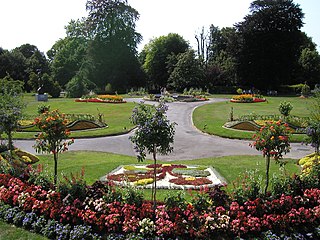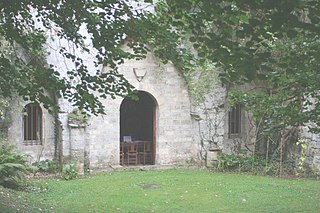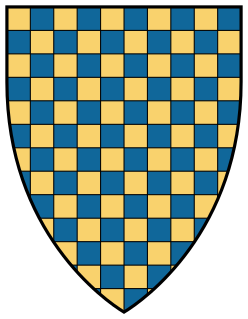
William I, usually known as William the Conqueror and sometimes William the Bastard, was the first Norman king of England, reigning from 1066 until his death in 1087. A descendant of Rollo, he was Duke of Normandy from 1035 onward. By 1060, following a long struggle to establish his throne, his hold on Normandy was secure. In 1066, following the death of Edward the Confessor, William invaded England, leading an army of Normans to victory over the Anglo-Saxon forces of Harold Godwinson at the Battle of Hastings, and suppressed subsequent English revolts in what has become known as the Norman Conquest. The rest of his life was marked by struggles to consolidate his hold over England and his continental lands, and by difficulties with his eldest son, Robert Curthose.

Hugh d'Avranches, nicknamed le Gros or Lupus, was from 1071 the second Norman Earl of Chester and one of the great magnates of early Norman England.

Avranches is a commune in the Manche department, and the region of Normandy, northwestern France. It is a subprefecture of the department. The inhabitants are called Avranchinais.

Odo of Rennes, Count of Penthièvre, was the youngest of the three sons of Duke Geoffrey I of Brittany and Hawise of Normandy, daughter of Richard I of Normandy. Eudon married Agnes of Cornouaille, the daughter of Alan Canhiart, Count of Cornouaille and sister of Hoel II, Duke of Brittany who was married in 1066 to Eudon's niece Hawise, Duchess of Brittany.

Richard I, also known as Richard the Fearless, was the count of Rouen from 942 to 996. Dudo of Saint-Quentin, whom Richard commissioned to write the "De moribus et actis primorum Normanniae ducum", called him a dux. However, this use of the word may have been in the context of Richard's renowned leadership in war, and not as a reference to a title of nobility. Richard either introduced feudalism into Normandy or he greatly expanded it. By the end of his reign, the most important Norman landholders held their lands in feudal tenure.

Hugh of Cyfeiliog, 5th Earl of Chester, also written Hugh de Kevilioc, was an Anglo-French magnate who was active in England, Wales, Ireland and France during the reign of King Henry II of England.
Robert de Beaumont, 1st Earl of Leicester, Count of Meulan, also known as Robert of Meulan, was a powerful Norman nobleman, one of the very few proven Companions of William the Conqueror during the Norman Conquest of England in 1066, and was revered as one of the wisest men of his age. Chroniclers spoke highly of his eloquence, his learning, and three kings of England valued his counsel. He was granted immense land-holdings in England by William the Conqueror and by Henry I and was created Earl of Leicester.

Ranulf de Blondeville, 6th Earl of Chester and 1st Earl of Lincoln, known in some references as the 4th Earl of Chester, was one of the "old school" of Anglo-Norman barons whose loyalty to the Angevin dynasty was consistent but contingent on the receipt of lucrative favours. He has been described as "almost the last relic of the great feudal aristocracy of the Conquest".

Herluin de Conteville (1001–1066), also sometimes listed as Herlwin of Conteville, was the stepfather of William the Conqueror, and the father of Odo of Bayeux and Robert, Count of Mortain, both of whom became prominent during William's reign. He died in 1066, the year his stepson conquered England.
William II, Count of Eu, feudal baron of Hastings was a first generation Anglo-Norman nobleman, Count of Eu and rebel.
Ranulf le Meschin, 3rd Earl of Chester (1070−1129) was a Norman magnate based in northern and central England. Originating in Bessin in Normandy, Ranulf made his career in England thanks to his kinship with Hugh d'Avranches - the Earl of Chester, the patronage of kings William II Rufus and Henry I Beauclerc, and his marriage to Lucy, heiress of the Bolingbroke-Spalding estates in Lincolnshire.
Ranulf de Briquessart was an 11th-century Norman magnate and viscount.

William I (Willame) de Percy (d.1096/9), 1st feudal baron of Topcliffe in North Yorkshire, known as Willame als gernons, was a French nobleman who arrived in England immediately after the Norman Conquest of 1066. He was the founder via an early 13th century female line of the powerful English House of Percy, Earls of Northumberland, and via an 18th century female line of the Dukes of Northumberland.
William Meschin was an Anglo-Norman nobleman and baron. The brother of the earl of Chester, Meschin participated in the First Crusade. After returning to England, he acquired lands both from King Henry I of England and by his marriage to an heiress.
The victims of the White Ship disaster on 25 November 1120 have been unevenly identified by various sources. The impact of the disaster on the throne of England is well-documented, and this article presents the details of what is known about the crew and passengers of the ill-fated voyage as well as those who chose not to travel on her.
The siege of the castle at Saint-Suzanne took place in a four-year period from 1083 to 1086, when the forces of William the Conqueror attempted to quell a rebellion led by Hubert de Beaumont-au-Maine and his liege lords against the rule of William. This was the only castle in Normandy that William did not succeed in taking.

The de Warenne family were a noble family in England that included the first Earls of Surrey, created by William the Conqueror in 1088 for William de Warenne, 1st Earl of Surrey, who was among his companions at the Battle of Hastings. The family originated in Normandy and as Earls, held land there and throughout England. When the senior male-line ended in the mid-12th century, the descendants of their heiress adopted the Warenne surname and continue as Earls of Surrey for another two centuries. Several junior lines also held land or prominent offices in England and Normandy.

The Constable of Chester was a mediaeval hereditary office held by the Barons of Halton. The functions of the Constable are unclear, possibly they related to the custody of Chester Castle, as was the main function of most mediaeval constables, but Sanders (1960) says the office-holder was constable for the entire County Palatine.

The Domesday Book of 1086 AD identifies King William the Conqueror's tenants-in-chief in Cestrescire (Cheshire), following the Norman Conquest of England. At the time, the County of Cheshire included South Lancashire and most of modern Flintshire and Wrexham counties in north Wales.











